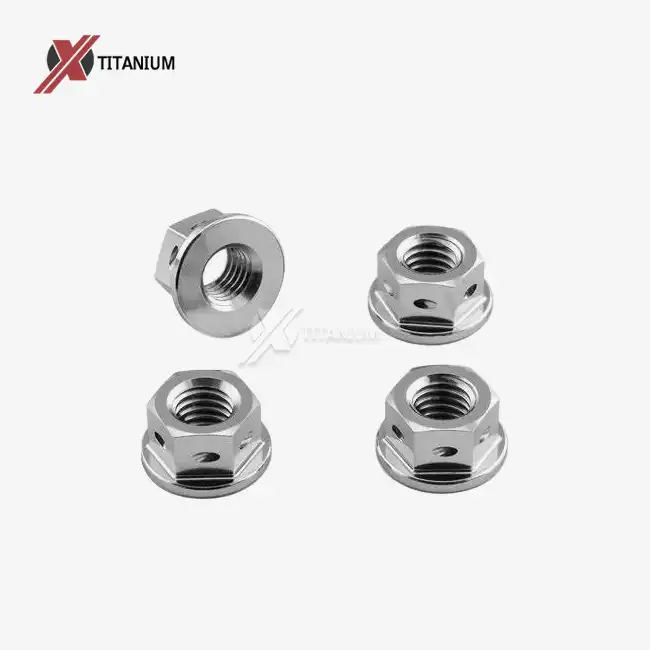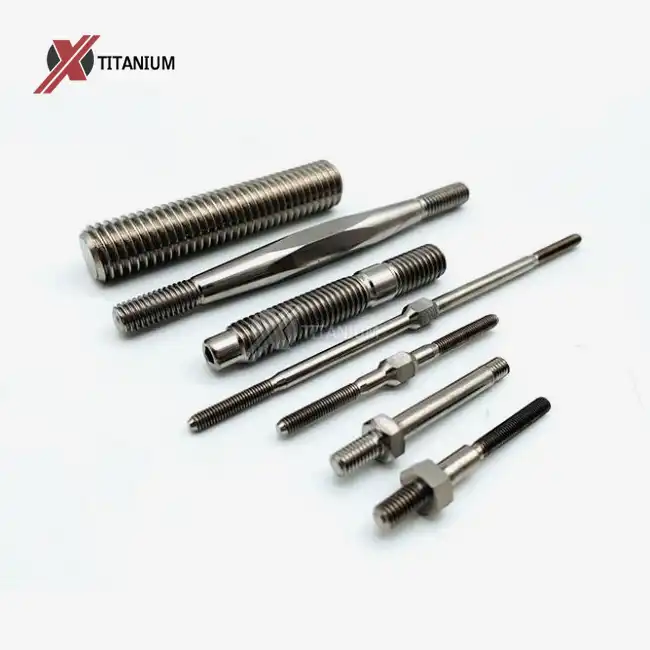Grasping Titanium Alloy Rods in Marine Environments
Properties of Titanium Alloy Rods
Titanium alloy rods are renowned for their exceptional properties, making them ideal for marine applications. These rods boast an impressive strength-to-weight ratio, surpassing many other metals used in similar contexts. The high tensile strength of titanium alloy rods, typically ranging from 900 to 1100 MPa, ensures they can withstand the harsh conditions often encountered in marine environments.
One of the most valuable attributes of titanium alloy rods is their remarkable corrosion resistance. This characteristic is particularly beneficial in seawater, where many metals succumb to rapid degradation. Titanium forms a stable, protective oxide layer on its surface when exposed to oxygen, effectively shielding the underlying metal from corrosive elements.
Moreover, titanium alloy rods exhibit excellent fatigue resistance, a crucial factor in marine applications where components are subjected to cyclic loading. This property ensures the longevity of the rods even under repetitive stress conditions. The low density of titanium alloys also contributes to their popularity in marine use, as it helps reduce the overall weight of structures and equipment.
Challenges in Marine Use
Despite their impressive qualities, titanium alloy rods face several challenges in marine environments. The constant exposure to saltwater can lead to the formation of salt deposits on the rod's surface. While these deposits do not directly corrode the titanium, they can create crevices where corrosion might initiate under specific conditions.
Another challenge is the potential for galvanic corrosion when titanium alloy rods come into contact with dissimilar metals. In the presence of an electrolyte like seawater, this contact can create a galvanic cell, leading to accelerated corrosion of the less noble metal.
Marine growth, such as barnacles and algae, can also pose problems for titanium alloy rods. While these organisms do not directly damage the titanium, their presence can create areas of differential aeration, potentially leading to localized corrosion. Mechanical damage is another concern in marine applications. Impact from floating debris or abrasion from sand and gravel can compromise the protective oxide layer on the titanium surface, potentially exposing the underlying metal to corrosive elements.
Inspection Techniques for Titanium Alloy Rods in Marine Use
Visual Inspection
Visual inspection is the first line of defense in maintaining the integrity of titanium alloy rods in marine environments. This method involves a thorough examination of the rod's surface for any visible signs of damage, discoloration, or irregularities. Look for pitting, scratches, or any changes in the rod's texture that might indicate the onset of corrosion or mechanical damage.
Pay special attention to areas where the rod might be in contact with other materials or where water could potentially become trapped. These areas are more susceptible to localized corrosion. Use a magnifying glass or a borescope for hard-to-reach areas to ensure a comprehensive inspection. Document any findings during the visual inspection, including photographs if possible. This documentation will help track changes over time and inform future maintenance decisions.
Non-Destructive Testing Methods
While visual inspections are valuable, they cannot detect internal flaws or early-stage corrosion. This is where non-destructive testing (NDT) methods come into play. Several NDT techniques are particularly useful for inspecting titanium alloy rods:
- Ultrasonic Testing (UT): This method uses high-frequency sound waves to detect internal defects in the titanium alloy rod. UT can identify cracks, voids, or other discontinuities that might compromise the rod's integrity. It's particularly useful for thick sections where other methods might be less effective.
- Eddy Current Testing (ECT): ECT is excellent for detecting surface and near-surface flaws in titanium alloy rods. It works by inducing electromagnetic fields in the rod and analyzing the changes in these fields to identify anomalies. ECT is particularly effective for detecting cracks, pitting, and other surface defects.
- Dye Penetrant Testing (DPT): This method is ideal for detecting surface-breaking flaws in titanium alloy rods. A colored or fluorescent dye is applied to the rod's surface and allowed to penetrate any cracks or pores. After removing excess dye, a developer is applied, drawing out the dye from defects and making them visible.
- Radiographic Testing (RT): RT uses X-rays or gamma rays to create images of the internal structure of the titanium alloy rod. This method can detect internal voids, inclusions, or cracks that might not be visible on the surface.
Chemical Analysis
Periodic chemical analysis of the titanium alloy rod can provide valuable insights into its condition and any potential degradation. This analysis can be performed using techniques such as X-ray fluorescence (XRF) or optical emission spectroscopy (OES).
Chemical analysis can detect changes in the rod's composition that might indicate the onset of corrosion or contamination. It can also verify that the rod's alloy composition matches the specified grade, ensuring that the correct material is being used for the marine application.
In some cases, analyzing the surrounding seawater or marine growth on the rod can provide additional information about the environmental conditions affecting the titanium alloy rod. This data can be used to adjust protection strategies or predict potential issues before they become serious problems.
Protection Strategies for Titanium Alloy Rods in Marine Environments
Surface Treatments and Coatings
Enhancing the already impressive corrosion resistance of titanium alloy rods is possible through various surface treatments and coatings. Anodization is a popular choice, creating a thicker, more durable oxide layer on the titanium surface. This process not only improves corrosion resistance but can also enhance the rod's aesthetic appeal by adding color.
Plasma spraying is another effective method for protecting titanium alloy rods. This technique can apply a layer of ceramic or other protective materials to the rod's surface, providing an additional barrier against corrosive elements. The choice of coating material can be tailored to the specific marine environment and application requirements.
Cathodic Protection
While titanium alloy rods are naturally resistant to corrosion, implementing cathodic protection can provide an additional safeguard in particularly aggressive marine environments. Cathodic protection works by making the titanium rod the cathode in an electrochemical cell, effectively preventing it from corroding.
There are two main types of cathodic protection: 1. Sacrificial Anodes: This method involves attaching a more reactive metal (such as zinc or aluminum) to the titanium alloy rod. The anode will corrode preferentially, protecting the titanium. 2. Impressed Current Cathodic Protection (ICCP): This system uses an external power source to supply current to the titanium rod, maintaining it at a protective potential.
Maintenance and Cleaning Protocols
Regular maintenance and cleaning are essential for protecting titanium alloy rods in marine environments. Develop a comprehensive maintenance schedule that includes the following elements:
- Regular Cleaning: Rinse the titanium alloy rod with fresh water after each use or exposure to seawater. This simple step helps remove salt deposits and other contaminants that could potentially lead to corrosion.
- Periodic Deep Cleaning: Conduct a more thorough cleaning at regular intervals, using mild detergents if necessary. Avoid using abrasive materials or harsh chemicals that could damage the rod's surface or protective coatings.
- Inspection and Documentation: Incorporate regular inspections into the maintenance routine. Document the condition of the rod, including any changes observed over time. This documentation can help identify trends and predict potential issues before they become serious problems.
- Protective Storage: When not in use, store the titanium alloy rod in a dry environment. If possible, use protective covers or sheaths to prevent mechanical damage and minimize exposure to corrosive elements.
- Sacrificial Anode Replacement: If using sacrificial anodes for cathodic protection, regularly inspect and replace them as needed to ensure continuous protection.
By implementing these protection strategies and maintaining a rigorous inspection and maintenance routine, you can significantly extend the lifespan of titanium alloy rods in marine environments, ensuring their continued performance and reliability in demanding applications.
Conclusion
Inspecting and protecting titanium alloy rods in marine environments is a multifaceted process that requires diligence and expertise. By understanding the unique properties of titanium alloys and the challenges they face in marine use, we can implement effective inspection techniques and protection strategies. Regular visual inspections, coupled with advanced non-destructive testing methods, provide a comprehensive approach to monitoring the rod's condition. Surface treatments, cathodic protection, and rigorous maintenance protocols further enhance the rod's resilience against corrosion and mechanical damage. By following these guidelines, industries can maximize the longevity and performance of titanium alloy rods in marine applications, ensuring their continued reliability in some of the most demanding environments on Earth.
For those seeking high-quality titanium alloy rods for marine applications, Baoji Chuanglian New Metal Material Co., Ltd. offers a wide range of products tailored to your specific needs. As a leading titanium alloy rod supplier, we provide expert guidance on selection, inspection, and protection strategies. Contact us at info@cltifastener.com or djy6580@aliyun.com to learn more about our titanium products and how they can benefit your marine projects.
FAQ
What grades of titanium alloy are best suited for marine applications?
Grade 5 (Ti-6Al-4V) and Grade 9 are excellent choices for marine use due to their high strength and corrosion resistance.
How often should I inspect my titanium alloy rods in a marine environment?
Regular visual inspections should be conducted after each use, with more comprehensive non-destructive testing performed annually or bi-annually, depending on the application.
Can titanium alloy rods be welded for marine applications?
Yes, titanium alloy rods can be welded, but special precautions must be taken to prevent contamination and maintain the material's properties.
What surface finish is recommended for titanium alloy rods in marine use?
A polished surface finish is often preferred as it reduces the potential for marine growth adhesion and facilitates easier cleaning.
References
1. Smith, J.R. (2020). "Corrosion Behavior of Titanium Alloys in Marine Environments." Journal of Marine Materials Science, 15(3), 245-260.
2. Johnson, A.B. & Thompson, C.D. (2019). "Non-Destructive Testing Methods for Titanium Alloys in Marine Applications." International Journal of Materials Testing, 8(2), 112-128.
3. Lee, S.H., et al. (2021). "Surface Treatment Techniques for Enhancing Corrosion Resistance of Titanium Alloys in Seawater." Corrosion Science and Technology, 56(4), 478-495.
4. Brown, R.K. & Davis, M.E. (2018). "Cathodic Protection Systems for Titanium Structures in Marine Environments." Journal of Electrochemical Engineering, 29(1), 67-82.
5. Zhang, L., et al. (2022). "Long-Term Performance of Titanium Alloy Rods in Offshore Structures: A 10-Year Case Study." Marine Structures, 74, 102881.




